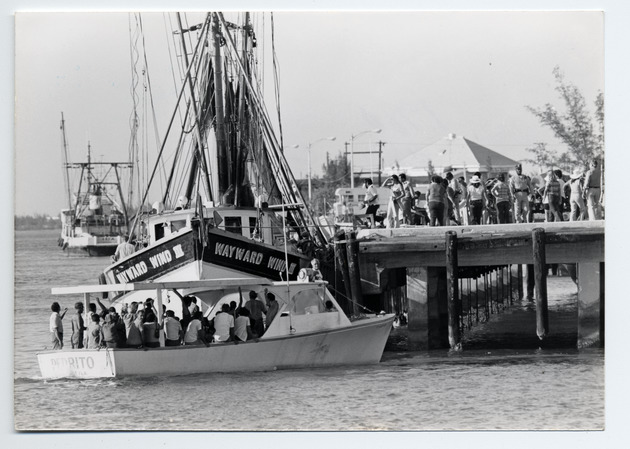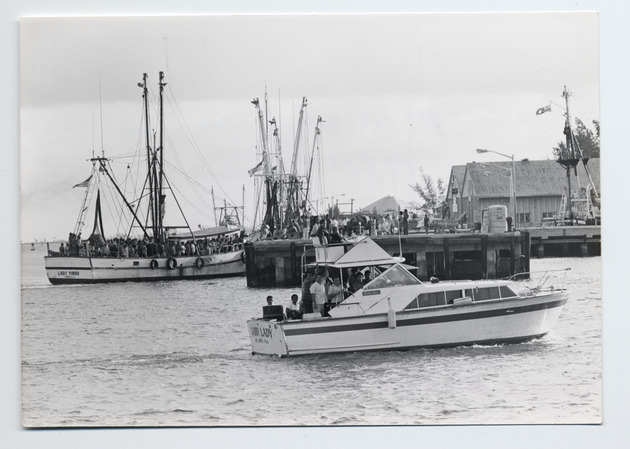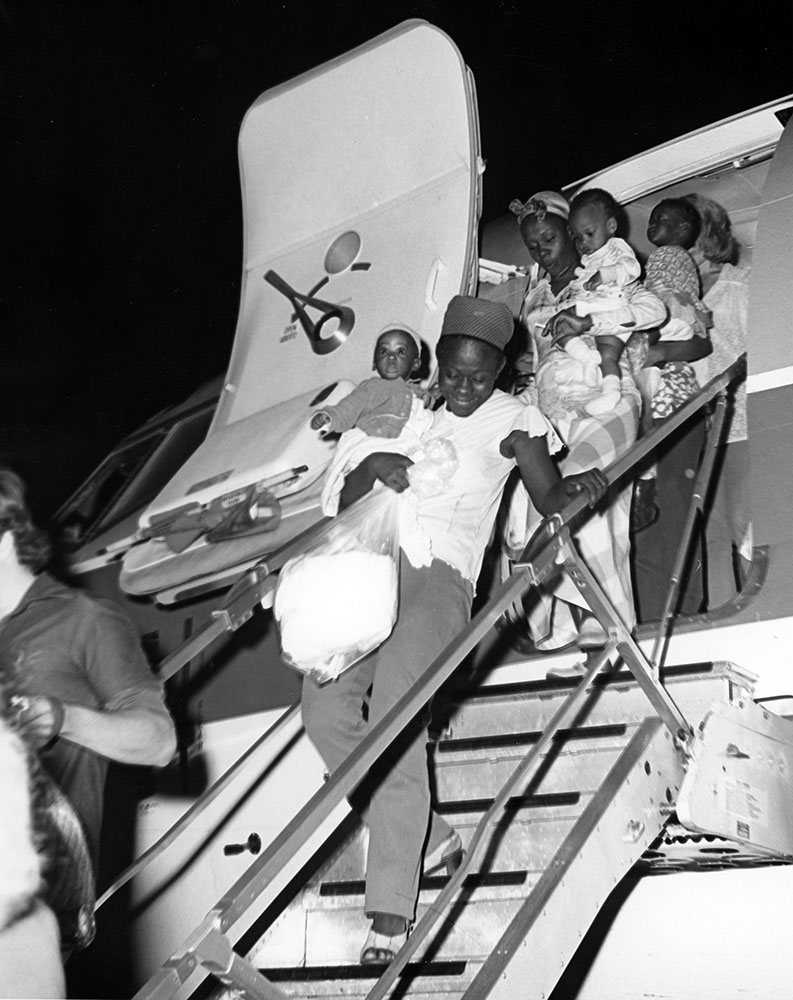
THE MARIEL BOATLIFT OF 1980 / EL ÉXODO DEL MARIEL DE 1980
In April 1980, popular discontent with Fidel Castro’s regime led over 10,000 Cubans to occupy the Peruvian Embassy in Havana, demanding asylum in the United States. Bolstered by the reaction of the international scenario (and President Jimmy Carter’s gesture to welcome 3,000 of the Cubans at the embassy as refugees into the U.S.), Castro then announced on national television that he would be opening the port of Mariel—located just 20 miles west of Havana—for all Cubans who wished to migrate. Within a matter of hours, the Cuban American community in South Florida had undertaken a massive boatlift. Over 1,200 boats sailed in what was known as the “Freedom Flotilla,” which continued until September 26, 1980, and brought a total of 124,769 Cubans to the shores of Florida.
En abril de 1980, el descontento popular con el gobierno de Fidel Castro llevó a más de 10.000 cubanos a ocupar la embajada de Perú en La Habana y a exigir asilo político en los Estados Unidos. Motivado por las críticas del escenario internacional (y por el gesto del presidente Jimmy Carter de recibir en Estados Unidos a 3.000 de los cubanos protestando en la embajada), Castro entonces anunció en televisión nacional la apertura del puerto de Mariel (ubicado solo a 30 kilómetros al oeste de La Habana) para todos los cubanos que desearan emigrar. En cuestión de horas, la comunidad cubano-estadounidense en el sur de la Florida había emprendido un enorme traslado vía embarcaciones marítimas. Más de 1.200 embarcaciones navegaron en lo que se conoció como la “Flotilla de la Libertad”, que continuó hasta el 26 de septiembre de 1980 y trajo un total de 124.769 cubanos a las costas de la Florida.

Photo of the Mariel Boatlift. Image courtesy of the Ida Woodward Barron Collection at the May Hill Russell Library, Florida International University.
The Carter Administration declared the situation an emergency on May 6, 1980, and the Federal Emergency Management Agency (FEMA) began to coordinate the federal effort to respond to the crisis. FEMA, however, had been created only a year before, on April 1, 1979, and its personnel had limited experience dealing with a human migration crisis. On July 15, 1980 the Carter administration established the Cuban-Haitian Immigration Task Force (CHITF) which took over the planning and management of a system of processing centers.
La administración Carter declaró una situación de emergencia el 6 de mayo de 1980, y la Agencia Federal para el Manejo de Emergencias (FEMA, por sus siglas en inglés) comenzó a coordinar el esfuerzo federal para responder a la crisis. Sin embargo, FEMA se había creado solo un año antes, el 1 de abril de 1979, y su personal tenía una experiencia muy limitada en el manejo de una crisis de migración humana. El 15 de julio de 1980, la administración Carter estableció el Grupo de Trabajo sobre la Inmigración Cubano-Haitiana (CHITF, por sus siglas en inglés), que se hizo cargo de la planificación y la gestión de un sistema de centros de procesamiento.

Photo of the Mariel Boatlift. Image courtesy of the Ida Woodward Barron Collection at the May Hill Russell Library, Florida International University.
The processing camps for Cuban migrants were opened at four military bases across the U.S: Eglin Air Force Base in Florida, Fort Chaffee in Arkansas, Fort Indiantown Gap in Pennsylvania, and Fort McCoy in Wisconsin. These facilities began to house Mariel migrants as early as May 3, 1980 (at Eglin) and at one point in June of 1980, over 62,000 Cubans (almost half of all Mariel migrants) were in these camps waiting to be processed.
Los campamentos de procesamiento para inmigrantes cubanos se abrieron en cuatro bases militares en todo Estados Unidos: la base aérea de Eglin en Florida, Fort Chaffee en Arkansas, Fort Indiantown Gap en Pensilvania y Fort McCoy en Wisconsin. Estas instalaciones comenzaron a albergar a los migrantes del Mariel ya el 3 de mayo de 1980 (en Eglin) y en un momento dado, en junio de 1980, más de 62.000 cubanos (casi la mitad de todos los inmigrantes del Mariel) se encontraban en estos campamentos esperando ser procesados.
Life at these Mariel camps and after leaving these facilities, however, is a segment of history that has remained overlooked by the extensive bibliography dedicated to the Mariel exodus. The delayed military detention endured by thousands of Mariel migrants in these camps nonetheless was a pivotal point in the history of the Mariel exodus, particularly in the reconfiguration of the Cuban American community beyond the more economically affluent Cuban-American enclaves in South Florida. The majority of refugees who faced the most difficulties to resettle out of these Mariel camps were lower-class, Black, single young men.
La vida en estos campamentos del Mariel, así como después de salir de ellos, es un segmento de la historia que sigue siendo ignorado por la gran bibliografía dedicada al Mariel. Sin embargo, este período de detención militar que soportaron miles de refugiados de Mariel fue un punto crucial en la historia del éxodo del Mariel, en particular en la reconfiguración de la comunidad cubanoamericana más allá del sur de Florida, ya que la mayoría de los refugiados que enfrentaron las mayores dificultades para reasentarse fuera de los campamentos eran hombres jóvenes solteros, negros o mestizos, de clase baja.
The present exhibit describes some of the ways in which the resettlement of Mariel refugees in Wisconsin was impacted by the bureaucracy of U.S federal government and U.S immigration authorities. While a myth of deviancy and criminality had been manufactured by Cuban authorities for those leaving via the Mariel port, this narrative was amplified by the militarized nature of the Mariel resettlement camps, and it was widely disseminated by local and national American press. All these factors negatively affected the social and economic development of Mariel migrants, particularly in predominantly white and segregated U.S communities such as La Crosse.
La presente exhibición describe algunas de las formas en que la burocracia del gobierno federal de los Estados Unidos y las autoridades de inmigración de los Estados Unidos afectaron el reasentamiento de los refugiados de Mariel en Wisconsin. Si bien las autoridades cubanas habían fabricado un mito de criminalidad para quienes salían por el puerto de Mariel, esta narrativa fue amplificada por la naturaleza militarizada de los campos de reasentamiento de Mariel y ampliamente difundida por la prensa estadounidense local y nacional. Todos estos factores, eventualmente, afectaron negativamente el desarrollo social y económico de los migrantes de Mariel, particularmente en comunidades estadounidenses predominantemente blancas y segregadas como La Crosse.
Last Updated Date
The La Crosse Public Library welcomes patron participation and comments on the La Crosse Public Library’s social media and in our online forums. All LPL online sites are governed by general rules of respectful civil discourse. Individual patrons are fully responsible for everything that they post.
The La Crosse Public Library does not discriminate against any views. However, we reserve the right to remove content that violates the below rules, without consent. We do not verify the identity of participants.
- The Library will remove:
- Off topic contributions
- Content that contains obscenity, nudity, defamation or hate speech (Speech that targets people or groups based on race, ethnicity, religion, gender, or any other protected status).
- Content that threatens to harm individuals, groups, or organizations
- Spam and content that promotes services or products, or that involves political campaigning or lobbying.
- Comments that give the appearance of legal, medical or financial advice.
- The Library may remove
- Content that contains personal information (whether your own or someone else's), including home address, home or cell phone number, or personal e-mail address, in order to protect privacy.
- Gratuitous links to sites.
- Repeat submissions of the same (or very similar) contributions will be viewed as spam and may result in the content being removed.
- The Library will only post content from participants over 13 years of age.
- Communications made through social media posts, e-mail, webinars, and messaging systems will in no way constitute a legal or official notice or comment to the La Crosse Public Library or any official or employee of the Library for any purpose.
- All user-generated content is released into the public domain unless the participant clearly states otherwise,
- Users who do not comply with these standards of conduct may be blocked.
Disclaimer for links posted on our Website or Social Media
External links are being provided as a convenience and for informational purposes only; they do not constitute an endorsement or an approval by the La Crosse Public Library of any of the products, services or opinions of the corporation or organization or individual. The La Crosse Public Library bears no responsibility for the accuracy, legality or content of the external site or for that of subsequent links. Contact the external site for answers to questions regarding its content.
Reviewed and approved by Library Board, November 2021


